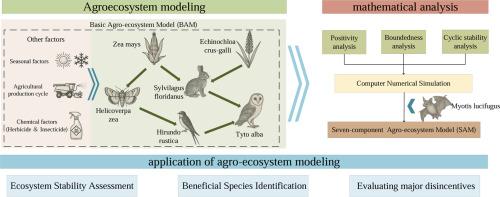胁迫下玉米农业生态系统动态建模与分析
IF 3.2
3区 环境科学与生态学
Q2 ECOLOGY
引用次数: 0
摘要
基于Lotka-Volterra竞争方程,以美国中西部玉米农业生态系统为例,建立了一个基本的农业生态系统食物网模型。我们提出了一个玉米农业生态系统的动态模型,以量化各种人类管理实践如何影响系统稳定性和生物多样性。该模型结合了多个种群和季节动态。通过正性分析、有界分析和周期稳定性分析,从数学上验证了其稳定性和合理性。为了研究特定工业化农业实践的影响,我们在模型中引入了农业生产周期和化学制剂(杀虫剂和除草剂)。进一步评价了引进小棕蝠对生态系统其他组成部分的防虫效果。通过对模型拟合结果的分析,我们提出了稳定性评估框架、鉴定有益物种的标准以及确定玉米显性抑制因素的阈值。这些工具使我们能够量化每个因素对农业生态系统的影响。我们的研究结果表明,特定的工业化农业实践显著影响了模型系统,潜在地降低了其生物多样性和生态稳定性。此外,我们还模拟了化学制剂和蝙蝠对农业产量和生态系统稳定性的影响。这些结果为优化农业可持续经营策略提供了定量依据。本文章由计算机程序翻译,如有差异,请以英文原文为准。

Modeling and analysis of maize agroecosystem dynamics with stresses
Based on the Lotka–Volterra competitive equations, we developed a basic agroecosystem food web model using the corn agroecosystems of the U.S. Midwest as a case study. We present a dynamic model of a maize agroecosystem to quantify how various human management practices impact system stability and biodiversity. The model incorporates multiple populations and seasonal dynamics. We mathematically validated its stability and rationality through positive analysis, boundedness analysis, and periodic stability analysis. To investigate the effects of specific industrialized agricultural practices, we introduced the agricultural production cycle and chemical agents (insecticides and herbicides) into the model. We further assessed the pest control effect of introducing the little brown bat (Myotis lucifugus) on other components of the ecosystem. By analyzing the model-fitting results, we proposed a stability evaluation framework, a criterion for identifying beneficial species, and a threshold for determining the dominant inhibitory factors affecting corn. These tools allowed us to quantify the impact of each factor on the agroecosystem. Our findings indicate that specific industrialized agricultural practices significantly affect the modeled system, potentially reducing its biodiversity and ecological stability. In addition, we modelled the effects of chemical agents and bats on agricultural yields and ecosystem stability. These results provide a quantitative basis for optimizing sustainable agricultural management strategies.
求助全文
通过发布文献求助,成功后即可免费获取论文全文。
去求助
来源期刊

Ecological Modelling
环境科学-生态学
CiteScore
5.60
自引率
6.50%
发文量
259
审稿时长
69 days
期刊介绍:
The journal is concerned with the use of mathematical models and systems analysis for the description of ecological processes and for the sustainable management of resources. Human activity and well-being are dependent on and integrated with the functioning of ecosystems and the services they provide. We aim to understand these basic ecosystem functions using mathematical and conceptual modelling, systems analysis, thermodynamics, computer simulations, and ecological theory. This leads to a preference for process-based models embedded in theory with explicit causative agents as opposed to strictly statistical or correlative descriptions. These modelling methods can be applied to a wide spectrum of issues ranging from basic ecology to human ecology to socio-ecological systems. The journal welcomes research articles, short communications, review articles, letters to the editor, book reviews, and other communications. The journal also supports the activities of the [International Society of Ecological Modelling (ISEM)](http://www.isemna.org/).
 求助内容:
求助内容: 应助结果提醒方式:
应助结果提醒方式:


